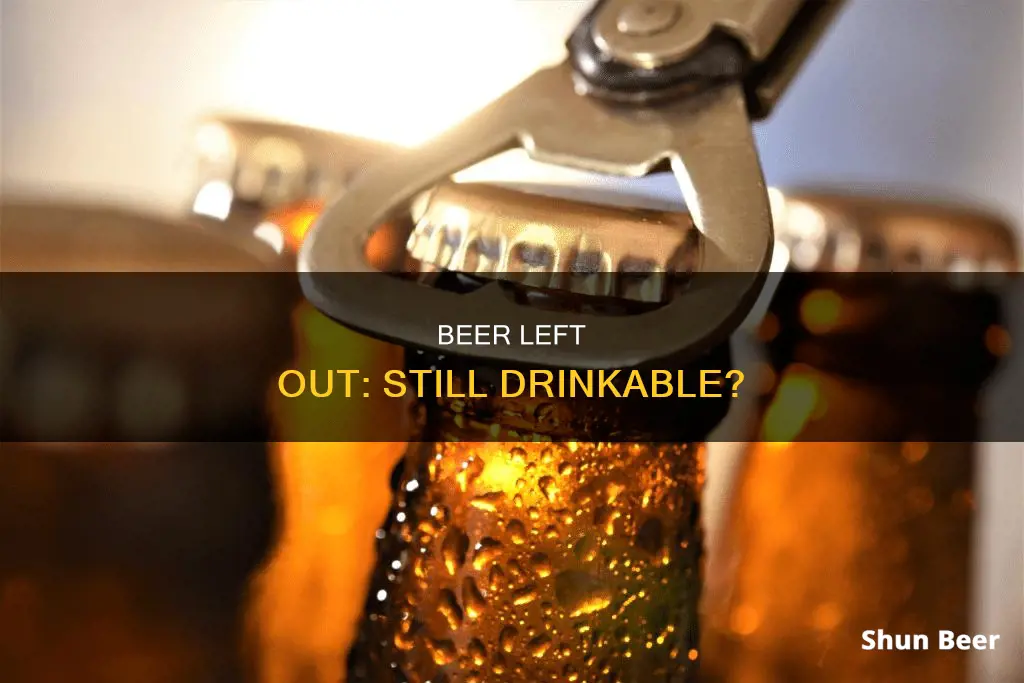
Beer is a delicate drink, and its flavour can be affected by a variety of factors, including temperature, oxygen, and light exposure. So, what happens if you leave your beer sitting out? The good news is that, in most cases, you can still drink it. Beer has a relatively long shelf life, and even after it has been opened, it can be safely consumed for up to two days, according to some sources. However, the flavour and quality will deteriorate over time, and you may notice changes in its taste, appearance, and aroma.
| Characteristics | Values |
|---|---|
| Is it safe to drink? | Yes, drinking beer left out overnight is safe. |
| Taste | The beer will be flat and stale, and its flavour will be affected. |
| Expiry | Beer does expire but it won't be unsafe to consume, just unpleasant. |
| Oxidation | Beer begins to oxidise when left out, causing changes in colour, appearance, aroma and taste. |
| Temperature | Beer exposed to very warm temperatures can be affected in flavour within a couple of days. |
| UV Rays | Exposure to UV rays can cause the compounds in beer to break down, so beer should be kept out of direct sunlight. |
| Bacterial Infestation | Although rare, bacterial infestation can occur, especially in opened bottles and cans. |
| Refrigeration | Refrigerating an open beer can slow oxidation and preserve its freshness for a little longer. |

Beer's shelf life
Beer does expire, but it doesn't become unsafe to drink. The flavour and quality will degrade over time, however, meaning very old beer is probably not worth drinking. Beer is best consumed fresh, especially hop-heavy styles like IPAs, as the hops that keep microbes out of beer are also one of the more delicate characteristics of beer.
A sealed beer can stay at optimal quality for about 4 to 6 months when stored at room temperature. However, this changes once the bottle is opened. An open beer will only be fresh for 1-2 days, and its taste will be far from pleasant after 3 days, even though drinking it won't expose you to any health hazards.
The shelf life of beer depends on several factors, including whether the bottle is open or not, and the type of beer. Stronger beers, such as stouts and porters, tend to last longer than lighter beers like lagers and pilsners. Beer stored in a refrigerator will also last longer than beer stored at room temperature.
To extend the shelf life of beer, it should be stored in a cool, dry, dark place, and sealed beer bottles or cans should be stored upright to minimise the surface area exposed to oxygen.
Root Beer's Alcoholic Mystery: Beverage's Surprising History
You may want to see also

Oxidation
Oxygen exposure is, therefore, a significant factor affecting beer's shelf life and quality. When beer comes into contact with oxygen, it can cause oxidation, degrading the beverage's flavour and changing its colour. Bottled beer is more susceptible to oxygen exposure than canned beer. To minimise this risk, beer should be stored upright to reduce the surface area in contact with oxygen.
Additionally, proper storage conditions are crucial in preventing oxidation. Beer should be stored in a cool, dry place, away from direct sunlight, and at controlled temperatures, preferably between 35 and 55 degrees Fahrenheit (2 to 13 degrees Celsius). Warm storage conditions can promote oxidation.
Old Beer: Is It Safe to Drink?
You may want to see also

Exposure to light
The wavelengths of light that cause beer to skunk fall between 350 and 550 nanometers. Light in this range is associated with purple, blue, and green colours. Sunlight contains all these wavelengths and is therefore the most effective at causing beer to skunk. Incandescent and halogen lights emit a broader spectrum of light wavelengths, but their effect on beer is reduced as they emit more light in the longer-wavelength range (yellow, orange, red, and burgundy colours) that does not cause skunking.
In contrast, LED and fluorescent lights emit more specific wavelengths, with major peaks around 400 nm, making them more likely to cause beer to skunk than incandescent and halogen lights. As a result, it is recommended to avoid storing beer in direct sunlight or under LED or fluorescent lighting. Stainless steel containers are ideal for blocking light, while brown glass bottles help to filter out the wavelengths that cause skunking. Clear glass bottles, on the other hand, allow all wavelengths of light to pass through, increasing the risk of skunking.
The effect of light on beer is particularly noticeable in lighter-coloured beers, as they absorb a narrower spectrum of light wavelengths compared to darker beers. Beers packaged in clear or green bottles are also more susceptible to skunking due to their exposure to UV light. Amber-coloured bottles are preferred by some brewers as they block out more UV light, reducing the risk of skunking.
Skunking occurs due to the interaction of UV light with isomerized hop compounds, which produce 3-methylbut-2-ene-1-thiol (3-MBT). This compound is highly detectable by humans, even in very low concentrations. While the effect of light on beer during the fermentation process is less well-understood, some studies have shown that beer fermented in direct sunlight can develop a lightstruck character.
Beer and Smirnoff: A Match Made in Heaven?
You may want to see also

Exposure to bacteria
Another indication of bacterial contamination is cloudiness in the beer. This occurs when bacteria cause proteins and other compounds to clump together, giving the beverage a cloudy appearance. However, it is important to note that not all cloudy beers are spoiled, as some craft beers have a hazy appearance for flavor and texture.
Bacteria can also affect the aroma of the beer, diluting or altering its fragrance. Additionally, bacteria can accumulate in beer lines, affecting the flavor and posing potential health risks to consumers. The most common bacteria found in beer lines include Pediococcus, Lactobacillus, Obesumbacterium, Pectinatus, and Zymomonas.
To prevent bacterial contamination, it is crucial to maintain proper sanitation and cleanliness during the brewing and storage process. Ensuring that the beer is stored in a cool, dry place, minimizing exposure to UV rays, and sealing the bottles or cans tightly can help extend the shelf life and maintain the quality of the beer.
Beer and Yeast Infections: Is There a Link?
You may want to see also

Flat beer
From a historical perspective, flat beer has its roots in ancient times. Before the discovery and invention of force carbonation methods, all beer was naturally flat due to the brewing and storage processes. Ancient cultures in China and the Neolithic period brewed alcoholic beverages commonly referred to as beer, and their methods often resulted in flat beer.
In modern times, some beer styles are still served with minimal or no carbonation. For example, straight (unblended) lambic, barleywine, and sahti beers have little to no carbonation. Cask beers, popular in the UK, also have very low levels of carbonation as they are not served under pressure. Additionally, some people choose to drink their beer at room temperature, which can cause it to go flat, as they believe it enhances the flavour.
Ultimately, the preference for flat or carbonated beer comes down to individual taste. Some people enjoy the smoother, less spicy taste of flat beer, while others relish the fizz and refreshment provided by carbonation. However, it's important to note that beer that has been left out for too long may not just go flat but also spoil, developing strange tastes, odours, and even bacteria growth, making it unsafe to consume. Therefore, while it's safe to drink a beer that has been left out overnight, it's best to consume it within 24-48 hours of opening to enjoy its optimal taste and quality.
Beer and Low FODMAP Diet: What's the Verdict?
You may want to see also
Frequently asked questions
Yes, you can drink a beer that has been left out overnight. It won't spoil nor will it taste bad, as long as the temperature of the room was moderate.
Beer can be left out for about two days before there's a significant loss of taste and flavour. After one to two days, the beer won't taste perfect, but it will still be safe to drink.
Refrigerating an open beer after leaving it out can slow oxidation and preserve its freshness for a little longer. However, the overall quality and taste of the beer may still be affected as exposure to oxygen will continue, even in cold temperatures.
An open beer that has gone bad will likely be darker or cloudy, and may have particles or sediment floating in it. Off-smells like vinegar or rotten eggs, and unusual flavours such as sourness or excessive bitterness, are also common in spoiled beer.
To extend the shelf life of beer, store it in a cool, dry place at a temperature between 35 and 46 degrees Fahrenheit (2 to 13 degrees Celsius). Keep the beer away from light and store it upright to minimise oxygen exposure.







